3RD TERM
3RD TERM
SCHEME OF WORK
WEEK TOPIC
1. Revision/Benefits of Recreation: (a) Benefits- (i) provides avenue for recreation, (ii) carry over values of skills, (iii) create room for fun and enjoyment, (iv) gives avenue for social interaction, (v) promotion of mental alertness, (vii) promotion of social, emotional stability.(b)Computer Games: various types of computer games:- nature park, Beach rally, vehicle rally, play stations, etc.
2. Meaning and classes of Food: (a) Meaning of food (b) Different types of food.(c) classes of food-carbon-hydrate, protein, Fat and oil, Minerals, Vitamins, water.
3. Meaning and classes of food: (d)importance of food– eliminate hunger, provides energy, enhance growth, resistance to disease, recovery from illness, for entertainment, as source of income.
4. Wrestling:(a) History of wrestling (b) Traditional wrestling e.g. kokuwa, Ijakadi, Ngba, (c) Modern wrestling-Greco- Roman.
5. Wrestling: (a) Importance of wrestling (b) wrestling skills. Skills of attack: offensive and defensive positions, escape.
6. Swimming (a) Basic swimming skills. Crawl, breast stroke, back stroke, butterfly. Aquatic sports—Swimming, water polo, canoeing, synchronize.
7. Prevention of communicable diseases(a)Diseases preventive measure—adequate nutrition., clean environment use of clean and safe water., proper disposal of refuge and sewage, seeking and getting treatment in time, good hygiene, immunization ,good ventilation, health education ,vaccination..
8. Gender participation in sport. (a) Definition of gender (b) Facts and fallacies about female participation in sports (c) Women reproduction and sports (c) Health consequences on premarital sex on sport performance (d ) Importance of self esteem assertiveness and communication skills in sports.
9 .Female genital Mutilation FGM (a) Meaning of FGM (c) Health implication of FGM
10. Child abuse (a) Meaning of child abuse (b) Types of child abuse -_____Physical, psychological, economical sexual (c) Consequences of child abuse (d) Solutions to child abuse.
11. Revision
BASIC TEXTBOOK
1. Essentials of Physical & Health Education for JSS, BK 1; By Akinseye Saint Erazmus
WEEK TOPIC
1. Revision/Benefits of Recreation: (a) Benefits- (i) provides avenue for recreation, (ii) carry over values of skills, (iii) create room for fun and enjoyment, (iv) gives avenue for social interaction, (v) promotion of mental alertness, (vii) promotion of social, emotional stability.(b)Computer Games: various types of computer games:- nature park, Beach rally, vehicle rally, play stations, etc.
2. Meaning and classes of Food: (a) Meaning of food (b) Different types of food.(c) classes of food-carbon-hydrate, protein, Fat and oil, Minerals, Vitamins, water.
3. Meaning and classes of food: (d)importance of food– eliminate hunger, provides energy, enhance growth, resistance to disease, recovery from illness, for entertainment, as source of income.
4. Wrestling:(a) History of wrestling (b) Traditional wrestling e.g. kokuwa, Ijakadi, Ngba, (c) Modern wrestling-Greco- Roman.
5. Wrestling: (a) Importance of wrestling (b) wrestling skills. Skills of attack: offensive and defensive positions, escape.
6. Swimming (a) Basic swimming skills. Crawl, breast stroke, back stroke, butterfly. Aquatic sports—Swimming, water polo, canoeing, synchronize.
7. Prevention of communicable diseases(a)Diseases preventive measure—adequate nutrition., clean environment use of clean and safe water., proper disposal of refuge and sewage, seeking and getting treatment in time, good hygiene, immunization ,good ventilation, health education ,vaccination..
8. Gender participation in sport. (a) Definition of gender (b) Facts and fallacies about female participation in sports (c) Women reproduction and sports (c) Health consequences on premarital sex on sport performance (d ) Importance of self esteem assertiveness and communication skills in sports.
9 .Female genital Mutilation FGM (a) Meaning of FGM (c) Health implication of FGM
10. Child abuse (a) Meaning of child abuse (b) Types of child abuse -_____Physical, psychological, economical sexual (c) Consequences of child abuse (d) Solutions to child abuse.
11. Revision
BASIC TEXTBOOK
1. Essentials of Physical & Health Education for JSS, BK 1; By Akinseye Saint Erazmus
WEEK 1
TOPIC: (a) Revision of last term’s work
(b) Recreation.
Contents: (a) Benefits of recreation
(b) Computer games.
BENEFITS OF RECREATION
(i) provides avenues for recreation
(ii) carry over values of skills
(iii) creates room for fun and enjoyment
(iv) gives avenue for social interaction
(v) promotion of mental alertness (vi) promotion of social emotional stability.

COMPUTER GAMES
Various types of computer games – nature park , beach rally, vehicle rally, play stations etc

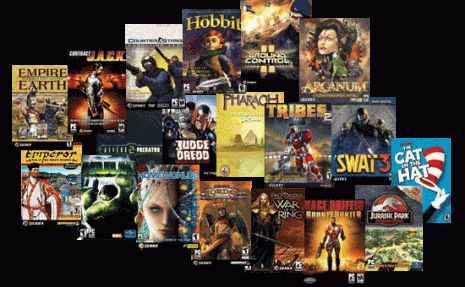
Evaluation:
1. What are the benefits of recreation?
2. Mention various types of computer games.
(b) Recreation.
Contents: (a) Benefits of recreation
(b) Computer games.
BENEFITS OF RECREATION
(i) provides avenues for recreation
(ii) carry over values of skills
(iii) creates room for fun and enjoyment
(iv) gives avenue for social interaction
(v) promotion of mental alertness (vi) promotion of social emotional stability.

COMPUTER GAMES
Various types of computer games – nature park , beach rally, vehicle rally, play stations etc


Evaluation:
1. What are the benefits of recreation?
2. Mention various types of computer games.
WEEK 2
Topic: Meaning and classes of food.:
Contents: (i) Meaning of food:
(ii) Classes of food
(iii) Types of food
SUB-TOPIC 1: Meaning of food:
Food is a substance which when taken into the body yield materials which can produce energy yield substance for growth and repair energy .Yields substance for growth and repair of our body tissues .It should be valuable in the regulation of our body functions and it should not be harmful to the body. Good food is the basis of good health and well – being.
Classes of food
There are six classes of food – Carbohydrates – Proteins – Fats and oil – Mineral salts – Vitamins – Water.
Classes .....Sources .....Functions
Carbohydrate..... Cassava, Yam, Potatoes, maize and Rice .....Provides energy, needs of the body.
Protein .....Fish, Meat, Vegetables, Fruits and Beans..... Body building, repair and replace worn out tissues.
Fats and oil..... Animal oil, Palm oil, Butter, Groundnut..... Regulate body temperature
Mineral salts..... Milk, Meat, Liver, Cheese, Vegetable and Sea foods..... Proper functioning of the body
Vitamins..... Liver, Eggs, Fish, Oil, Citrus and Tomatoes..... Protection against diseases
Water..... Rain, Spring, Brooks, Vegetables, Fruits, Beverages and Tea..... For easy digestion and maintenance of body fluid.
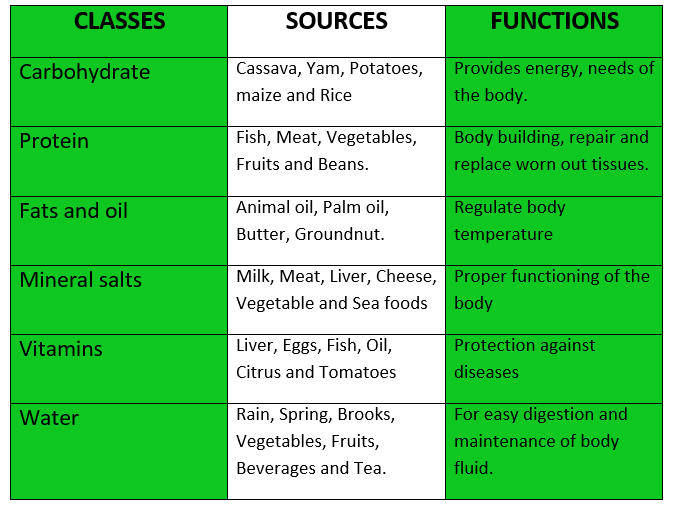
Different types of foods
Rice , Gari , Semovitta , Bread , Tea , Egg, Vegetables, Yam , Beans , Porridge.
Evaluation ;- 1. What is food.
2. How many classes of food do we have ? List them.
3. Name some foods you know
Contents: (i) Meaning of food:
(ii) Classes of food
(iii) Types of food
SUB-TOPIC 1: Meaning of food:
Food is a substance which when taken into the body yield materials which can produce energy yield substance for growth and repair energy .Yields substance for growth and repair of our body tissues .It should be valuable in the regulation of our body functions and it should not be harmful to the body. Good food is the basis of good health and well – being.
Classes of food
There are six classes of food – Carbohydrates – Proteins – Fats and oil – Mineral salts – Vitamins – Water.
Classes .....Sources .....Functions
Carbohydrate..... Cassava, Yam, Potatoes, maize and Rice .....Provides energy, needs of the body.
Protein .....Fish, Meat, Vegetables, Fruits and Beans..... Body building, repair and replace worn out tissues.
Fats and oil..... Animal oil, Palm oil, Butter, Groundnut..... Regulate body temperature
Mineral salts..... Milk, Meat, Liver, Cheese, Vegetable and Sea foods..... Proper functioning of the body
Vitamins..... Liver, Eggs, Fish, Oil, Citrus and Tomatoes..... Protection against diseases
Water..... Rain, Spring, Brooks, Vegetables, Fruits, Beverages and Tea..... For easy digestion and maintenance of body fluid.

Different types of foods
Rice , Gari , Semovitta , Bread , Tea , Egg, Vegetables, Yam , Beans , Porridge.
Evaluation ;- 1. What is food.
2. How many classes of food do we have ? List them.
3. Name some foods you know
WEEK 3
Topic: Meaning and classes of foods.(contd)
Contents: (i) Definition of food
(ii) Importance of food
(iii) Groups of food
MEANING OF FOOD
Food is anything we eat whether solid or liquid that nourishes the body.
IMPORTANCE OF FOOD
- Food eliminates hunger
- It provides energy
- It enhances growth
- It is a resistance to disease
- Makes one to recover from illness
- It serves as a source of income.
for the purpose of adequate nutrition

BASIC FOOD GROUPS
It is necessary to classify food types into groups .There are five groups.
- Milk and milk producer group
- Meat group.
- Fruits and vegetable group
- Bread and cereal group
- Timber group

Evaluation.
1. What is the meaning of food?
2. What are the importance of food ?
3. How many groups can we classify food ?
Assignment.
Read Essential of physical and health Education Pgs 97-103
Contents: (i) Definition of food
(ii) Importance of food
(iii) Groups of food
MEANING OF FOOD
Food is anything we eat whether solid or liquid that nourishes the body.
IMPORTANCE OF FOOD
- Food eliminates hunger
- It provides energy
- It enhances growth
- It is a resistance to disease
- Makes one to recover from illness
- It serves as a source of income.
for the purpose of adequate nutrition

BASIC FOOD GROUPS
It is necessary to classify food types into groups .There are five groups.
- Milk and milk producer group
- Meat group.
- Fruits and vegetable group
- Bread and cereal group
- Timber group

Evaluation.
1. What is the meaning of food?
2. What are the importance of food ?
3. How many groups can we classify food ?
Assignment.
Read Essential of physical and health Education Pgs 97-103
WEEK 4
Topic: Wrestling.
Content:
(a) History of wrestling
(b) Traditional wrestling.
(c) Modern wrestling
i. Free style
ii. Greco Roman style
iii. Differences in styles
HISTORY OF WRESTLING
Wrestling is a Mental Art. It began when man wrestled to overcome animals. Human wrestling was known to be on increate, Egypt, Greece and China almost at the same time. The sports developed in Greece. It was included into the Olympic Games in 704 BC.
TRADITIONAL WRESTLING
Traditional wrestling is peculiar to any group. They are done in honour of gods and during festivals. In some places it is done basically to select the champions in a village to be honoured. In some villages, there are arenas for wrestling. The rules vary from place to place. African wrestling has specific rules for judging it.
The Igbo traditional wrestling is a very popular sport in the Igbo community. It is a practice and acknowledgement of skill and strength as well as promotion of indigenous language , culture , norms, values, and traditions by young, physically capable Igbo men. In Igbo Land a man is believed to prove his physical strength when he is able to fight off his aggressors and so wrestling shows strength and courage. Before the wresting season young men who will be competing train for months. A young Man who comes out Victorious in a traditional wrestling is admired and respected by all ,He is seen as a Warrior or a distinguished wrestler.
Traditional Wrestling sometimes are used to settle local dispute and conflict between two Villages .It is also Used to determine the right groom in cases where a young woman has many suitors, in such cases a wrestling match is arranged where all the suitors battle it out and whoever emerges victorious marries the woman .It is also a form of entertainment, usually the chief of the village and his chieftains are seated the villagers gather around the village square too to watch.
Wrestling matches take place in traditional rings ,a ring filled with sand which cushions their fall. A flute boy is present to provide special tunes that stir the heart ,this is believed to give added strength to the weak, spectators are also present to cheer the wrestlers on and encourage them. The winner of the contest takes home a prize.
[youtube]https://www.youtube.com/watch?v=3jrbIfyQXGE[/youtube]
EVALUATION
1. State the brief history of wrestling.
2. Discuss traditional wrestling
MODERN WRESTLING
It is divided into freestyles and Greco Roman styles
Content:
i. Freestyles- Freestyle is the general wrestling pattern found in the international
ii Greco Roman– This is the combination of the Greeks and the Romans

[youtube]https://www.youtube.com/watch?v=V2J7z1SRoeE[/youtube]
Content:
(a) History of wrestling
(b) Traditional wrestling.
(c) Modern wrestling
i. Free style
ii. Greco Roman style
iii. Differences in styles
HISTORY OF WRESTLING
Wrestling is a Mental Art. It began when man wrestled to overcome animals. Human wrestling was known to be on increate, Egypt, Greece and China almost at the same time. The sports developed in Greece. It was included into the Olympic Games in 704 BC.
TRADITIONAL WRESTLING
Traditional wrestling is peculiar to any group. They are done in honour of gods and during festivals. In some places it is done basically to select the champions in a village to be honoured. In some villages, there are arenas for wrestling. The rules vary from place to place. African wrestling has specific rules for judging it.
The Igbo traditional wrestling is a very popular sport in the Igbo community. It is a practice and acknowledgement of skill and strength as well as promotion of indigenous language , culture , norms, values, and traditions by young, physically capable Igbo men. In Igbo Land a man is believed to prove his physical strength when he is able to fight off his aggressors and so wrestling shows strength and courage. Before the wresting season young men who will be competing train for months. A young Man who comes out Victorious in a traditional wrestling is admired and respected by all ,He is seen as a Warrior or a distinguished wrestler.
Traditional Wrestling sometimes are used to settle local dispute and conflict between two Villages .It is also Used to determine the right groom in cases where a young woman has many suitors, in such cases a wrestling match is arranged where all the suitors battle it out and whoever emerges victorious marries the woman .It is also a form of entertainment, usually the chief of the village and his chieftains are seated the villagers gather around the village square too to watch.
Wrestling matches take place in traditional rings ,a ring filled with sand which cushions their fall. A flute boy is present to provide special tunes that stir the heart ,this is believed to give added strength to the weak, spectators are also present to cheer the wrestlers on and encourage them. The winner of the contest takes home a prize.
[youtube]https://www.youtube.com/watch?v=3jrbIfyQXGE[/youtube]
EVALUATION
1. State the brief history of wrestling.
2. Discuss traditional wrestling
MODERN WRESTLING
It is divided into freestyles and Greco Roman styles
Content:
i. Freestyles- Freestyle is the general wrestling pattern found in the international
ii Greco Roman– This is the combination of the Greeks and the Romans

[youtube]https://www.youtube.com/watch?v=V2J7z1SRoeE[/youtube]
WEEK 5
Topic: WRESTLING
Content: (A) Importance of Wrestling.
(B) Wrestling Skill: Skills of Attacks, Offensive and Defensive Positions, Escapes.
The Importance of Wrestling by BJA Instructor Gerry Navarra
Aside from running, wrestling is the world’s oldest sport. Early Babylonian and Egyptian reliefs depict wrestlers performing many of the holds used in the modern sport. In ancient Greece, wrestling occupied a prominent place in legend, literature, and the Olympic Games. However, its origin predates all those events. When early man first tackled one of his contemporaries to stop him from stealing his food, the double-leg takedown—and the sport—were born.
While there are many traditional ethnic forms of wrestling practiced throughout the world, there are three major styles. Two are Greco-Roman and freestyle, which are practiced internationally and contested in the Olympics. The third is collegiate or folkstyle, which is unique to the United States.
Greco-Roman wrestling prohibits attacks below the waist. Single and double-leg takedowns are illegal. Wrestlers try to control the upper body. Because of all the clinch work necessary in Greco-Roman, the style lends itself well to Mixed Martial Arts.
Freestyle has similar rules and scoring to Greco-Roman, except that a wrestler can make leg attacks. It is the more popular of the international styles.
The United States is the only country that practices collegiate or folkstyle wrestling. The slams and suplexes seen in the international styles are not permitted. Emphasis is placed on control rather than position. For example, imagine a wrestler throwing an opponent who hits the mat and then rolls out and returns to a standing position. In Greco-Roman or freestyle, he or she would be awarded points depending on how much of the opponent’s back hit the mat. If the throw was large enough, the round would be over. On the other hand, the collegiate wrestler would receive no points unless the opponent was held down after the throw and the takedown was “secured”. Folkstyle is great for sport Brazilian Jiu-Jitsu because positions generally must be held for three seconds before points are awarded.
Wrestling is an important study for anyone serious about BJJ or MMA. After all, every fight starts on the feet. If you have any doubts about its significance in BJJ, watch Jacaré hit an ankle pick or Marcelo Garcia work an arm drag from their feet.
UFC commentator Joe Rogan often calls wrestling the best foundation for MMA. And looking at the list of successful fighters who began their careers in wrestling, it is hard to argue with him. Randy Couture, Dan Henderson, Brock Lesnar, Josh Koscheck, Jon Fitch and so many more transitioned easily into MMA from wrestling. Besides forging a work ethic, the takedowns and takedown defense learned in wrestling allows a fighter to dictate where the action goes. Some fighters like Clay Guida use their wrestling as anti-jiu-jitsu, smothering their opponents and squashing submission attempts.
Not only will wrestling improve performance in other martial arts, but character as well. The legendary American wrestler Dan Gable once said, “After wrestling, everything else in life is easy.” Try it sometime. See if he was wrong.

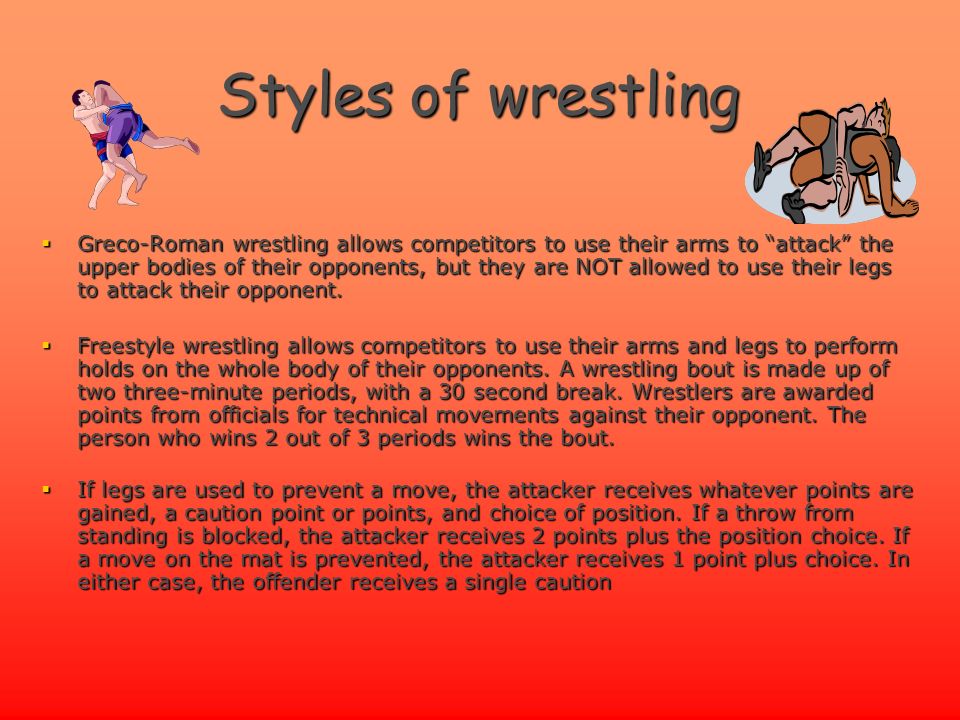
IMPORTANCE OF WRESTLING
1. It is a defensive sport.
2. It is for recreation.
3. It is a means of income.
4. It is use for exercises.
5. It is used for entertainment.
SKILLS IN WRESTLING AND PRACTICE
1. Hold or grips
2. Throws
3. Stance.
4. Attacks.
5. Offensives and defensive
6. Escapes
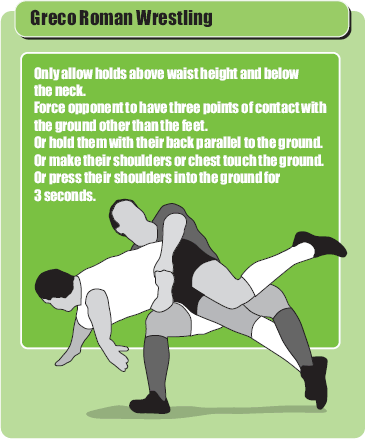
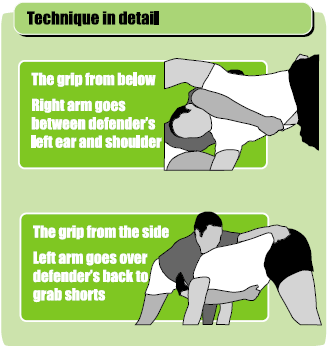
The 7 Basic Skills of Wrestling
Although wrestling has many moves and techniques, USA Wrestling considers the sport to have seven basic skills.
The seven basic skills are:
• Stance
• Motion
• Level Change
• Penetration
• Lifting
• Back Step
• Back Arch
Stance:
While in the neutral (standing) position, some wrestlers prefer a square stance while others prefer a staggered stance. Either stance can work equally well. Make sure you have most of your weight on the balls of your feet as opposed to your heels. You should never be standing straight up and leaving yourself open to a takedown from your opponent. You should utilize a comfortable but effective stance. You need a stance that allows you to attack as well as defend.
Motion:
Wrestling involves a tremendous amount of motion. You may circle your opponent. You may attack your opponent with a takedown attempt. You may snap your opponent to the mat and spin around behind him. You may sprawl to defend against a takedown. You need to learn to move fluidly and quickly. You don't want to be clumsy or sloppy. You need to execute moves explosively and crisply.
Level Change:
Before a wrestler shoots a takedown, he must lower his level. This is accomplished by lowering his hips. When a wrestler sprawls to counter a takedown he is also using level change. In addition, a wrestler may lower and raise his level to force a reaction from his opponent. A wrestler needs to be able to maintain good posture while changing levels. For instance, you don't want to get overextended when shooting a takedown because you forgot to lower your level first. Always bend at the knees, not at the waist.
Penetration:
Obviously, when you shoot for a takedown on your opponent, you don't merely reach for his legs or dive wildly for his legs. Instead, you make sure you are close enough to your opponent and then take a deep penetration step keeping your back straight and your head up. You lower your level and penetrate deeply being sure to keep your hips forward and beneath your shoulders while you drive through your opponent.
Lifting:
A wrestler often lifts his opponent off the mat when executing a takedown. He may also lift an opponent who has performed a stand up from the bottom position. He lifts his opponent and returns him to the mat. The legs and hips are most important when lifting. For instance, when you shoot a double leg, you don't lift with your back. You get your hips squarely beneath you and then use your leg and hip strength to lift your opponent off the mat. When a wrestler has been lifted off the mat, he is in a very vulnerable position lacking support and balance.
Back Step:
A back step is most often seen when a wrestler executes a throw.
Back Arch:
When a wrestler attempts a throw, he often pops his hips under his opponent while arching his back.
Other Skills:
Other important basic skills include setting up takedowns, pummeling, wrist control, and hand fighting.
[youtube]https://www.youtube.com/watch?v=sC3Vxv_ZI7k[/youtube]
EVALUATION
1. State two modern styles of wrestling
2. Differentiate traditional wrestling from Greco- Roman style.
3. State 3 importance of wrestling.
READING ASSIGNMENT: Essentials of PHE For Junior Secondary Schools book 1 by Akinseye Saint Erazmus pp 104 - 107
ASSIGNMENT:
1 Which of these is not a wrestling skill (a) starting position (b) take down (c) pinning (d)pushing
2. One of this not a wrestling quality (a)agility (b) balance (c) joy (d) Endurance
THEORY
1 State the benefits of traditional wrestling
2 What is knock out in wrestling?
Content: (A) Importance of Wrestling.
(B) Wrestling Skill: Skills of Attacks, Offensive and Defensive Positions, Escapes.
The Importance of Wrestling by BJA Instructor Gerry Navarra
Aside from running, wrestling is the world’s oldest sport. Early Babylonian and Egyptian reliefs depict wrestlers performing many of the holds used in the modern sport. In ancient Greece, wrestling occupied a prominent place in legend, literature, and the Olympic Games. However, its origin predates all those events. When early man first tackled one of his contemporaries to stop him from stealing his food, the double-leg takedown—and the sport—were born.
While there are many traditional ethnic forms of wrestling practiced throughout the world, there are three major styles. Two are Greco-Roman and freestyle, which are practiced internationally and contested in the Olympics. The third is collegiate or folkstyle, which is unique to the United States.
Greco-Roman wrestling prohibits attacks below the waist. Single and double-leg takedowns are illegal. Wrestlers try to control the upper body. Because of all the clinch work necessary in Greco-Roman, the style lends itself well to Mixed Martial Arts.
Freestyle has similar rules and scoring to Greco-Roman, except that a wrestler can make leg attacks. It is the more popular of the international styles.
The United States is the only country that practices collegiate or folkstyle wrestling. The slams and suplexes seen in the international styles are not permitted. Emphasis is placed on control rather than position. For example, imagine a wrestler throwing an opponent who hits the mat and then rolls out and returns to a standing position. In Greco-Roman or freestyle, he or she would be awarded points depending on how much of the opponent’s back hit the mat. If the throw was large enough, the round would be over. On the other hand, the collegiate wrestler would receive no points unless the opponent was held down after the throw and the takedown was “secured”. Folkstyle is great for sport Brazilian Jiu-Jitsu because positions generally must be held for three seconds before points are awarded.
Wrestling is an important study for anyone serious about BJJ or MMA. After all, every fight starts on the feet. If you have any doubts about its significance in BJJ, watch Jacaré hit an ankle pick or Marcelo Garcia work an arm drag from their feet.
UFC commentator Joe Rogan often calls wrestling the best foundation for MMA. And looking at the list of successful fighters who began their careers in wrestling, it is hard to argue with him. Randy Couture, Dan Henderson, Brock Lesnar, Josh Koscheck, Jon Fitch and so many more transitioned easily into MMA from wrestling. Besides forging a work ethic, the takedowns and takedown defense learned in wrestling allows a fighter to dictate where the action goes. Some fighters like Clay Guida use their wrestling as anti-jiu-jitsu, smothering their opponents and squashing submission attempts.
Not only will wrestling improve performance in other martial arts, but character as well. The legendary American wrestler Dan Gable once said, “After wrestling, everything else in life is easy.” Try it sometime. See if he was wrong.


IMPORTANCE OF WRESTLING
1. It is a defensive sport.
2. It is for recreation.
3. It is a means of income.
4. It is use for exercises.
5. It is used for entertainment.
SKILLS IN WRESTLING AND PRACTICE
1. Hold or grips
2. Throws
3. Stance.
4. Attacks.
5. Offensives and defensive
6. Escapes


The 7 Basic Skills of Wrestling
Although wrestling has many moves and techniques, USA Wrestling considers the sport to have seven basic skills.
The seven basic skills are:
• Stance
• Motion
• Level Change
• Penetration
• Lifting
• Back Step
• Back Arch
Stance:
While in the neutral (standing) position, some wrestlers prefer a square stance while others prefer a staggered stance. Either stance can work equally well. Make sure you have most of your weight on the balls of your feet as opposed to your heels. You should never be standing straight up and leaving yourself open to a takedown from your opponent. You should utilize a comfortable but effective stance. You need a stance that allows you to attack as well as defend.
Motion:
Wrestling involves a tremendous amount of motion. You may circle your opponent. You may attack your opponent with a takedown attempt. You may snap your opponent to the mat and spin around behind him. You may sprawl to defend against a takedown. You need to learn to move fluidly and quickly. You don't want to be clumsy or sloppy. You need to execute moves explosively and crisply.
Level Change:
Before a wrestler shoots a takedown, he must lower his level. This is accomplished by lowering his hips. When a wrestler sprawls to counter a takedown he is also using level change. In addition, a wrestler may lower and raise his level to force a reaction from his opponent. A wrestler needs to be able to maintain good posture while changing levels. For instance, you don't want to get overextended when shooting a takedown because you forgot to lower your level first. Always bend at the knees, not at the waist.
Penetration:
Obviously, when you shoot for a takedown on your opponent, you don't merely reach for his legs or dive wildly for his legs. Instead, you make sure you are close enough to your opponent and then take a deep penetration step keeping your back straight and your head up. You lower your level and penetrate deeply being sure to keep your hips forward and beneath your shoulders while you drive through your opponent.
Lifting:
A wrestler often lifts his opponent off the mat when executing a takedown. He may also lift an opponent who has performed a stand up from the bottom position. He lifts his opponent and returns him to the mat. The legs and hips are most important when lifting. For instance, when you shoot a double leg, you don't lift with your back. You get your hips squarely beneath you and then use your leg and hip strength to lift your opponent off the mat. When a wrestler has been lifted off the mat, he is in a very vulnerable position lacking support and balance.
Back Step:
A back step is most often seen when a wrestler executes a throw.
Back Arch:
When a wrestler attempts a throw, he often pops his hips under his opponent while arching his back.
Other Skills:
Other important basic skills include setting up takedowns, pummeling, wrist control, and hand fighting.
[youtube]https://www.youtube.com/watch?v=sC3Vxv_ZI7k[/youtube]
EVALUATION
1. State two modern styles of wrestling
2. Differentiate traditional wrestling from Greco- Roman style.
3. State 3 importance of wrestling.
READING ASSIGNMENT: Essentials of PHE For Junior Secondary Schools book 1 by Akinseye Saint Erazmus pp 104 - 107
ASSIGNMENT:
1 Which of these is not a wrestling skill (a) starting position (b) take down (c) pinning (d)pushing
2. One of this not a wrestling quality (a)agility (b) balance (c) joy (d) Endurance
THEORY
1 State the benefits of traditional wrestling
2 What is knock out in wrestling?
WEEK 6
Topic: Swimming:
(a) Basic swimming skills: crawl, breast stroke, back stroke, butterfly.
(b) Aquatic sports- swimming, water polo, canoeing, synchrony
CONTENT
1. History
2. Pool’s dimension and equipment
3. Officials
4. Importance of swimming
HISTORY
Swimming is the act of moving (propulsion) through water. Swimming is a life time sport. It has no age barrier – from youth to old age. Swimming started as early as early men. Man swam as he waded through water in pursuit of animals and escape for life from wild animals formal swimming started in Greece. The world governing body is Federation International De Notation Amateur (FINA) formed in 1908. The Nigerian Swimming Association was formed in 1958.
[youtube]https://www.youtube.com/watch?v=IZByircY9Kc[/youtube]
IMPORTANCE OF SWIMMING
Why do we swim?
Safety
Recreation
Competition
Entertainment
WATER SAFETY
1. Do not swim alone
2. Do not dive into unclear water
3. Do not fake danger
4. Do not run around the pool
5. Shower before swimming
6. Swim from deep to shallow part
WATER SANITATION
1. Do not blow nose into water
2. Do not spit into water
3. Shower before swimming
4. Do not carry street shoes into the pool environment
5. Chlorinate water regularly
6. Girls should put on shower cap
7. Girls should not swim during menstruation
HOW TO DEVELOP CONFIDENCE IN WATER
1. Pick up pebble under water
2. Fill bottles under water
3. Move round pool holding hands and dip in occasionally
4. Holding rail and kicking water
SUB TOPIC: POOLS DIMENSION AND EQUIPMENT
CONTENT
1. Pools dimension
2. Officials
3. Aquatics
4. Skills
POOL’S DIMENSION
50m x 21m
Depth 1.8m
Lanes 8 – 10 Olympic standard, ordinary standard 6 lanes
Width of lane 2.5m
Swimming kits are used as dressing for swimming
Starting gun or whistle
Paper for recording
Biro for writing
OFFICIALS
1. Referee
2. 2 (umpire)
3. Lane judges 2 each
4. Turning judges 2 each
5. Style judges 2 each
6. Fine keepers
7. Recorder
AQUATIC SPORTS
These are various water sports
Swimming
Water polo
Canoeing
Synchronise
Yachting
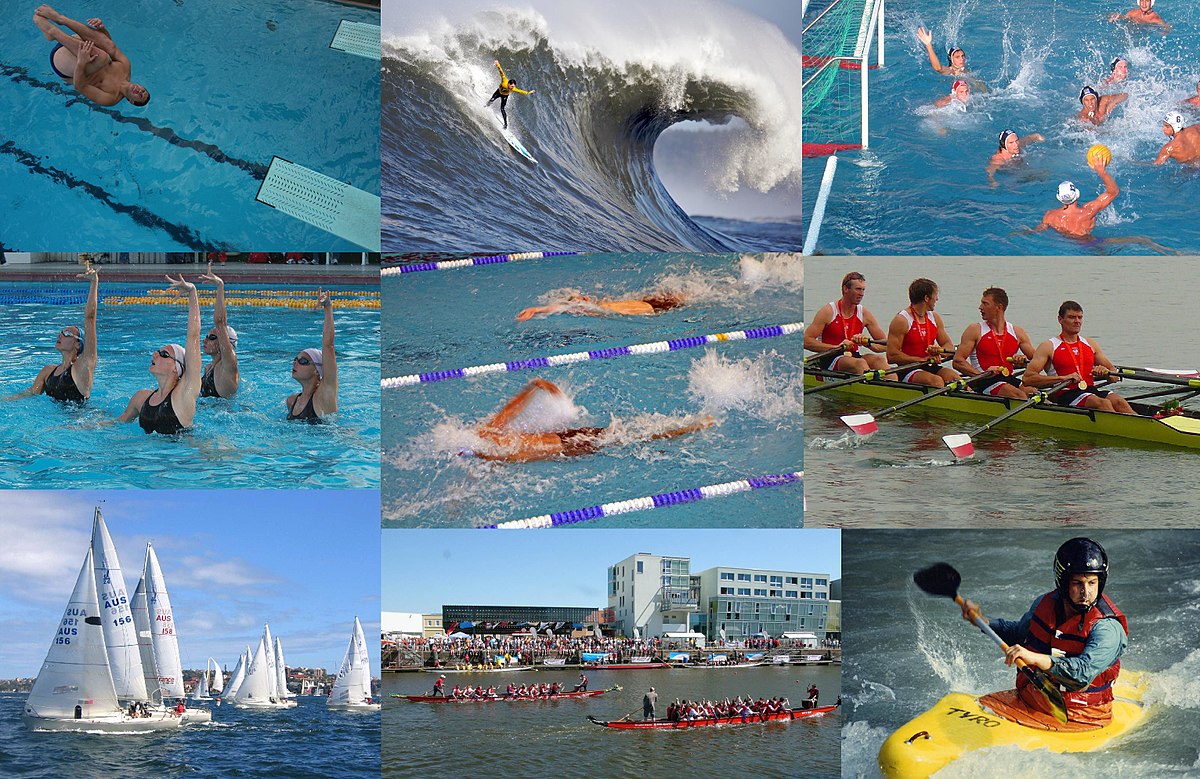
Swimming Skills Performance (Styles)
Front crawl
Breast stroke
Butterfly
Back stroke
Earliest swimming style, dog paddle
Fastest swimming style, front crawl
Style that can be performed on land, front crawl
[youtube]https://www.youtube.com/watch?v=nAPI9lWjgL8[/youtube]
[youtube]https://www.youtube.com/watch?v=n3CCzpY6-Es[/youtube]
EVALUATION
1. Briefly explain the history of swimming
2. State 4 importance of swimming and water safety
3. State pool dimension
READING ASSIGNMENT: Essentials of PHE For Junior Secondary Schools book 1 by Akinseye Saint Erazmus pp 108-113
ASSIGNMENT
Objective:
1. All are basic skills of swimming except
(a) confidence in water (b)floating (c) propulsion (d) kneeling
2. The following are basic swimming strokes except
(a)flying (b)crawl (c)butterfly (d) breast
3. One of the following is a facility in swimming
(a) wood (B) desk (c) pant (d) pool
Essay:
1. Draw the swimming court
2. State the benefits of swimming
(a) Basic swimming skills: crawl, breast stroke, back stroke, butterfly.
(b) Aquatic sports- swimming, water polo, canoeing, synchrony
CONTENT
1. History
2. Pool’s dimension and equipment
3. Officials
4. Importance of swimming
HISTORY
Swimming is the act of moving (propulsion) through water. Swimming is a life time sport. It has no age barrier – from youth to old age. Swimming started as early as early men. Man swam as he waded through water in pursuit of animals and escape for life from wild animals formal swimming started in Greece. The world governing body is Federation International De Notation Amateur (FINA) formed in 1908. The Nigerian Swimming Association was formed in 1958.
[youtube]https://www.youtube.com/watch?v=IZByircY9Kc[/youtube]
IMPORTANCE OF SWIMMING
Why do we swim?
Safety
Recreation
Competition
Entertainment
WATER SAFETY
1. Do not swim alone
2. Do not dive into unclear water
3. Do not fake danger
4. Do not run around the pool
5. Shower before swimming
6. Swim from deep to shallow part
WATER SANITATION
1. Do not blow nose into water
2. Do not spit into water
3. Shower before swimming
4. Do not carry street shoes into the pool environment
5. Chlorinate water regularly
6. Girls should put on shower cap
7. Girls should not swim during menstruation
HOW TO DEVELOP CONFIDENCE IN WATER
1. Pick up pebble under water
2. Fill bottles under water
3. Move round pool holding hands and dip in occasionally
4. Holding rail and kicking water
SUB TOPIC: POOLS DIMENSION AND EQUIPMENT
CONTENT
1. Pools dimension
2. Officials
3. Aquatics
4. Skills
POOL’S DIMENSION
50m x 21m
Depth 1.8m
Lanes 8 – 10 Olympic standard, ordinary standard 6 lanes
Width of lane 2.5m
Swimming kits are used as dressing for swimming
Starting gun or whistle
Paper for recording
Biro for writing
OFFICIALS
1. Referee
2. 2 (umpire)
3. Lane judges 2 each
4. Turning judges 2 each
5. Style judges 2 each
6. Fine keepers
7. Recorder
AQUATIC SPORTS
These are various water sports
Swimming
Water polo
Canoeing
Synchronise
Yachting

Swimming Skills Performance (Styles)
Front crawl
Breast stroke
Butterfly
Back stroke
Earliest swimming style, dog paddle
Fastest swimming style, front crawl
Style that can be performed on land, front crawl
[youtube]https://www.youtube.com/watch?v=nAPI9lWjgL8[/youtube]
[youtube]https://www.youtube.com/watch?v=n3CCzpY6-Es[/youtube]
EVALUATION
1. Briefly explain the history of swimming
2. State 4 importance of swimming and water safety
3. State pool dimension
READING ASSIGNMENT: Essentials of PHE For Junior Secondary Schools book 1 by Akinseye Saint Erazmus pp 108-113
ASSIGNMENT
Objective:
1. All are basic skills of swimming except
(a) confidence in water (b)floating (c) propulsion (d) kneeling
2. The following are basic swimming strokes except
(a)flying (b)crawl (c)butterfly (d) breast
3. One of the following is a facility in swimming
(a) wood (B) desk (c) pant (d) pool
Essay:
1. Draw the swimming court
2. State the benefits of swimming
WEEK 7
TOPIC: Communicable Diseases:.
CONTENT
1. Definition of communicable diseases
2. Types of communicable diseases
3. Agents of communicable diseases
4. Types of preventive measures
COMMUNICABLE DISEASES: These are diseases that can be transferred from one person to another A disease is when one departs from normal and it is unwell with functioning state of the body.
AGENTS OF COMMUNICABLE DISEASES
1. Air – borne diseases
2. Food borne diseases
3. Insect borne diseases
4. Contagious and sexually transmitted diseases
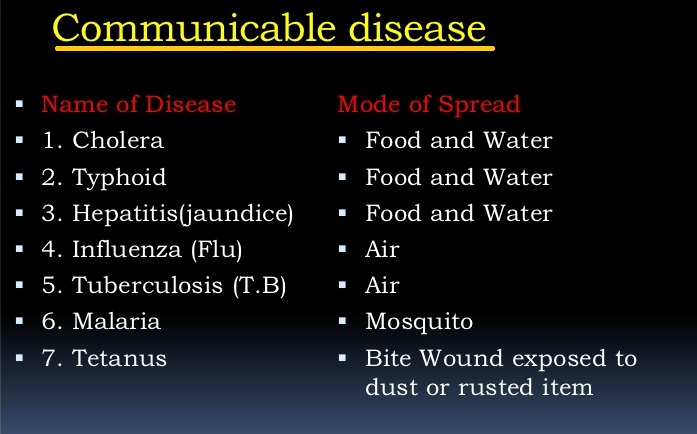
SIGNS OF COMMUNICABLE DISEASES
Red or watery eye
Skin rash
Cough
Frequent passing of feaces
Vomiting
Running note
Headache
Anaemia
Fever
EVALUATION
1. Define diseases
2. Mention two main types of diseases
3. List 5 agents of diseases
4. State 3 signs of communicable diseases
SUB TOPIC: PREVENTION OF COMMUNICABLE DISEASES
1. Prevention of communicable diseases
2. Examples of communicable diseases and sexually transmitted diseases HIV AIDS

PREVENTION OF COMMUNICABLE DISEASES
Maintain personal hygiene.
Cover food is protect them from flies
Protect the body from insect bites
Drink clean and safe water
Do not use the materials of other people
Do not spit indiscriminately
Go for immunization
Exposition to Health Education
Do not sleep in overcrowded room (good ventilation).
There should be proper disposal of refuse and sewage.
Wash fruits thoroughly before eating
Wash hand before eating food
Wash hands after visiting the toilet to pass feaces
Avoid pre-marital and outside marriage sex
SEXUALLY TRANSMITTED DISEASES (STD)
Sexually transmitted disease are: Human Immunodeficiency virus, (HIV), Acquired Immune Deficiency Syndrome, (AIDS).

TYPES OF COMMUNICABLE DISEASES
Typhoid
Diarrhoea
Tuberculoses
Syphilis
Chicken pox
Dysentery
Cholera
Measles
Influenza
Mumps
Common cold
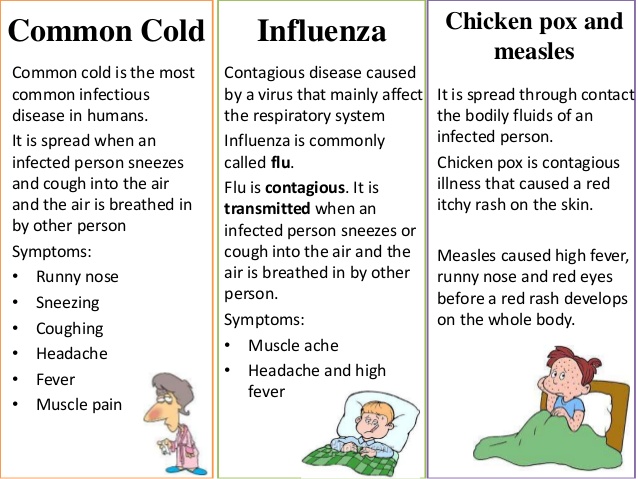
PREVENTION OF AIDS
1. Abstain from sex until you marry.
2. Be disciplined in sex issues.
3. Do not share razor blades, clippers, needles, syringes or other sharp instruments with people.
4. Be faithful not to have sex outside marriage.
5. Avoid taking alcoholic drinks and using intoxicating drugs.
6. Cover open wounds.
7. Do not share chewing stick, blades, needles and tooth brushes.

EVALUATION
1. List 3 sexually transmitted diseases
2. Discuss HIV/AIDS
READING ASSIGNMENT:
Essentials of PHE For Junior Secondary Schools book 1 by Akinseye Saint Erazmus pp 124-129
ASSIGNMENT
Objective:
(1) Which is not a communicable disease (a) bacteria (b)HIV
(c) small box (d) chicken pox
(2) Identify communicable disease here (a)obesity (b) cough
(c)diabetes (d) ulcer
Essay:
1. Explain the difference between communicable and non communicable diseases
2. State two preventive measures of communicable diseases
CONTENT
1. Definition of communicable diseases
2. Types of communicable diseases
3. Agents of communicable diseases
4. Types of preventive measures
COMMUNICABLE DISEASES: These are diseases that can be transferred from one person to another A disease is when one departs from normal and it is unwell with functioning state of the body.
AGENTS OF COMMUNICABLE DISEASES
1. Air – borne diseases
2. Food borne diseases
3. Insect borne diseases
4. Contagious and sexually transmitted diseases

SIGNS OF COMMUNICABLE DISEASES
Red or watery eye
Skin rash
Cough
Frequent passing of feaces
Vomiting
Running note
Headache
Anaemia
Fever
EVALUATION
1. Define diseases
2. Mention two main types of diseases
3. List 5 agents of diseases
4. State 3 signs of communicable diseases
SUB TOPIC: PREVENTION OF COMMUNICABLE DISEASES
1. Prevention of communicable diseases
2. Examples of communicable diseases and sexually transmitted diseases HIV AIDS

PREVENTION OF COMMUNICABLE DISEASES
Maintain personal hygiene.
Cover food is protect them from flies
Protect the body from insect bites
Drink clean and safe water
Do not use the materials of other people
Do not spit indiscriminately
Go for immunization
Exposition to Health Education
Do not sleep in overcrowded room (good ventilation).
There should be proper disposal of refuse and sewage.
Wash fruits thoroughly before eating
Wash hand before eating food
Wash hands after visiting the toilet to pass feaces
Avoid pre-marital and outside marriage sex
SEXUALLY TRANSMITTED DISEASES (STD)
Sexually transmitted disease are: Human Immunodeficiency virus, (HIV), Acquired Immune Deficiency Syndrome, (AIDS).

TYPES OF COMMUNICABLE DISEASES
Typhoid
Diarrhoea
Tuberculoses
Syphilis
Chicken pox
Dysentery
Cholera
Measles
Influenza
Mumps
Common cold

PREVENTION OF AIDS
1. Abstain from sex until you marry.
2. Be disciplined in sex issues.
3. Do not share razor blades, clippers, needles, syringes or other sharp instruments with people.
4. Be faithful not to have sex outside marriage.
5. Avoid taking alcoholic drinks and using intoxicating drugs.
6. Cover open wounds.
7. Do not share chewing stick, blades, needles and tooth brushes.

EVALUATION
1. List 3 sexually transmitted diseases
2. Discuss HIV/AIDS
READING ASSIGNMENT:
Essentials of PHE For Junior Secondary Schools book 1 by Akinseye Saint Erazmus pp 124-129
ASSIGNMENT
Objective:
(1) Which is not a communicable disease (a) bacteria (b)HIV
(c) small box (d) chicken pox
(2) Identify communicable disease here (a)obesity (b) cough
(c)diabetes (d) ulcer
Essay:
1. Explain the difference between communicable and non communicable diseases
2. State two preventive measures of communicable diseases
WEEK 8
TOPIC: GENDER PARTICIPATION IN SPORTS
CONTENT
1. Definition of gender.
2. Women reproduction and sports.
3. Facts and fallacies about female participation in sports.
4. Health consequences of pre-marital sex on sports performance.
5. Importance of self esteem, assertiveness and communication skills in sports.
Sub-Topic 1: DEFINITION OF GENDER
Gender means the sex of being a male or female. Gender participation in sports means how males or females take part in sports.
Reasons Why Female Participation In Sports In Nigeria Is Low:
Tradition
Beliefs
Weakness of women compared to men
Less blood cells compared to men

FACTS AND FALLACIES ABOUT FEMALE PARTICIPATION IN SPORTS
Sexual intercourse and having children reduces level of sports participation
Sports makes girls to be morally bankrupt (Promiscuous)
Girls become muscular and ugly
Women become barren
Difficulty in child bearing
Girls will not have life partners
Dull people are those that participate in sports
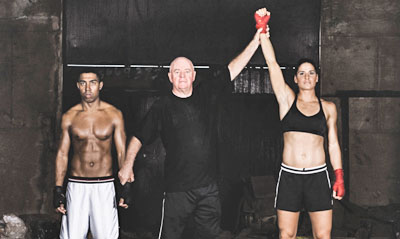
HEALTH CONSEQUENCES OF PRE – MARITAL –SEX ON SPORTS PERFORMANCE
1. Tendencies of poor performance
2. Unwanted pregnancy and abortion
3. May became barren
4. May not have a life partner
5. Proving right the fallacies for women participation in sports Nigeria being low
IMPORTANCE OF SELF ESTEEM, ASSERTIVENESS AND COMMUNICATION SKILLS IN SPORTS
Self esteem/Confidence can be defined as your assessment of your own self worth
Importance of self esteem
1 It builds self confidence
2 Leads towards a more productive future
3 Allows individual to feel good about whom they are and what they can do
4 It gives confidence to meet new challenges
5 Athletics competencies
6 Social acceptance
7 Scholastic competencies
ASSERTIVENESS
This is ability to say no because you know what you are capable of.
NON ASSERTIVENESS
This is a person who:
is often taken advantage of ,
feels helpless,
takes on every ones problem,
says yes to inappropriate demands.
Allows others to choose for him or her.

EVALUATION
1. Define gender
2. State the characteristics of boy and girls
3. Give four reasons why girls participate in sports in Nigeria less than boys.
CONTENT
1. Definition of gender.
2. Women reproduction and sports.
3. Facts and fallacies about female participation in sports.
4. Health consequences of pre-marital sex on sports performance.
5. Importance of self esteem, assertiveness and communication skills in sports.
Sub-Topic 1: DEFINITION OF GENDER
Gender means the sex of being a male or female. Gender participation in sports means how males or females take part in sports.
Reasons Why Female Participation In Sports In Nigeria Is Low:
Tradition
Beliefs
Weakness of women compared to men
Less blood cells compared to men

FACTS AND FALLACIES ABOUT FEMALE PARTICIPATION IN SPORTS
Sexual intercourse and having children reduces level of sports participation
Sports makes girls to be morally bankrupt (Promiscuous)
Girls become muscular and ugly
Women become barren
Difficulty in child bearing
Girls will not have life partners
Dull people are those that participate in sports

HEALTH CONSEQUENCES OF PRE – MARITAL –SEX ON SPORTS PERFORMANCE
1. Tendencies of poor performance
2. Unwanted pregnancy and abortion
3. May became barren
4. May not have a life partner
5. Proving right the fallacies for women participation in sports Nigeria being low
IMPORTANCE OF SELF ESTEEM, ASSERTIVENESS AND COMMUNICATION SKILLS IN SPORTS
Self esteem/Confidence can be defined as your assessment of your own self worth
Importance of self esteem
1 It builds self confidence
2 Leads towards a more productive future
3 Allows individual to feel good about whom they are and what they can do
4 It gives confidence to meet new challenges
5 Athletics competencies
6 Social acceptance
7 Scholastic competencies
ASSERTIVENESS
This is ability to say no because you know what you are capable of.
NON ASSERTIVENESS
This is a person who:
is often taken advantage of ,
feels helpless,
takes on every ones problem,
says yes to inappropriate demands.
Allows others to choose for him or her.

EVALUATION
1. Define gender
2. State the characteristics of boy and girls
3. Give four reasons why girls participate in sports in Nigeria less than boys.
WEEK 9
TOPIC: FEMALE GENITAL MUTILATION (FGM)
CONTENT
1. Meaning of Female Genital Mutilation (FGM)
2. Reasons for FGM
3. The types of FGM
4. Health Implication of FGM
Sub-Topic 1: Meaning of FGM
This is female circumcision which involves cutting away part or parts of the external genitalia or other injuries to the female genital for cultural or religious reasons that are non therapeutic reasons.
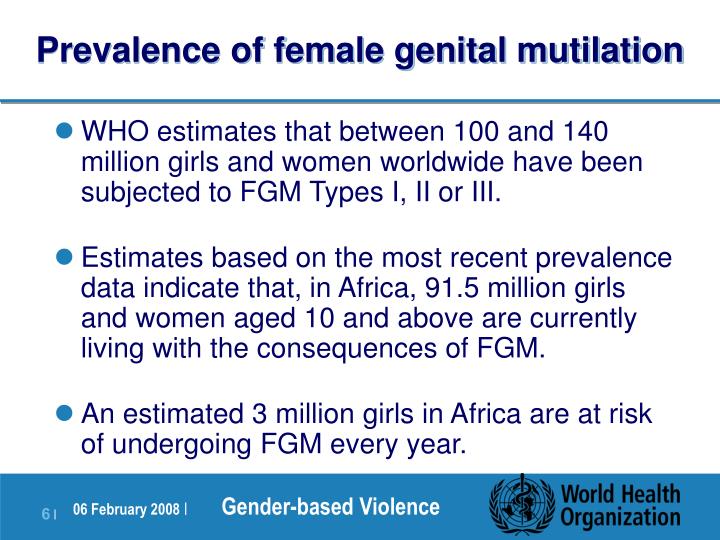
REASONS FOR FGM
Religions
Festival
Marriage
To prevent promiscuity
To promote chastity
Helps women to be obedient to their husbands

TYPES OF FGM
1. Amputation of Clitoris
2. Partial or total removal of labia minor
3. Removal of clitoris, labia minor and major
4. Many procedures:
i. Piercing
ii. Cauterization
iii. Scraping
iv. Corrosive substance
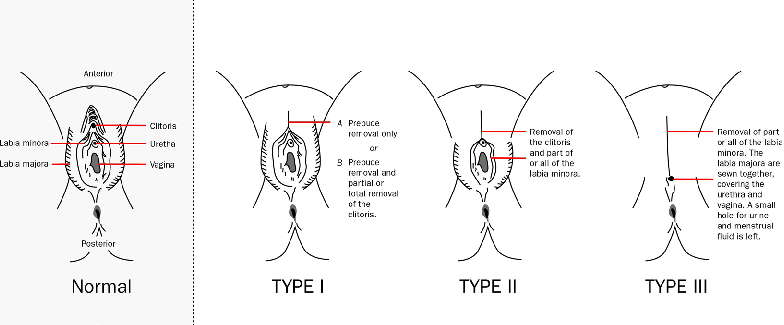
HEALTH IMPLICATIONS OF FGM
1. It causes diseases due to infections.
2. Deformity
3. Removes full enjoyment of sex.
4. It brings about complaints from partner
5. It can lead to death

EVALUATION
1. Write FGM in full
2. List 3 types of FGM
3. State 3 reasons for FGM
CONTENT
1. Meaning of Female Genital Mutilation (FGM)
2. Reasons for FGM
3. The types of FGM
4. Health Implication of FGM
Sub-Topic 1: Meaning of FGM
This is female circumcision which involves cutting away part or parts of the external genitalia or other injuries to the female genital for cultural or religious reasons that are non therapeutic reasons.

REASONS FOR FGM
Religions
Festival
Marriage
To prevent promiscuity
To promote chastity
Helps women to be obedient to their husbands

TYPES OF FGM
1. Amputation of Clitoris
2. Partial or total removal of labia minor
3. Removal of clitoris, labia minor and major
4. Many procedures:
i. Piercing
ii. Cauterization
iii. Scraping
iv. Corrosive substance

HEALTH IMPLICATIONS OF FGM
1. It causes diseases due to infections.
2. Deformity
3. Removes full enjoyment of sex.
4. It brings about complaints from partner
5. It can lead to death

EVALUATION
1. Write FGM in full
2. List 3 types of FGM
3. State 3 reasons for FGM
